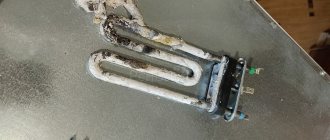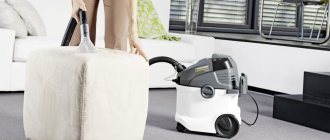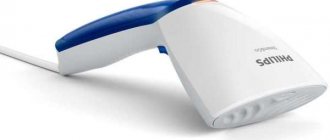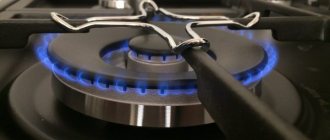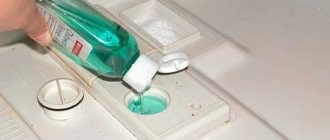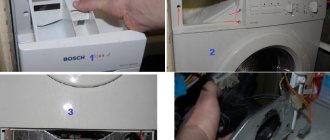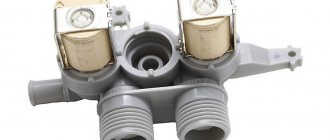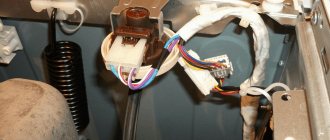The apartment is dusty. We should clean up. The equipment is already plugged in, you press the button, but nothing happens. It’s not clear what to do: take it to a repair shop or try to repair the vacuum cleaner yourself. Let's figure it out.
The instructions are universal and suitable for most models: AEG, Bosch Ergomaxx, Bimatek, Bissell, Black Decker, Bork, Clever Clean, Daewoo, Deebot, Dexter / Dexter, Dyson / Dyson, EIO Targa Duo / EIO Targa Duo, Electrolux Ergorapido, ZAC, TwinClean / Electrolux Ergorapido, TwinClean; Elenberg / Elenberg, GiNZZU / Ginzu, Gorenje / Gorenje, Gutrend / Gutrend, Hansa / Hansa, Hilti / Hilti, Hitachi / Hitachi, Hoover / Hoover, Iclebo / Iklebo, iLife / Ilife, Kambrook / Kambrok, Karcher SE / Karcher, Kirby / Kirby, Kitfort / Kitfort, LG Kompressor, VK / LG, LV, LG or, as is customary, LG Compressor; Makita / Makita, Metabo / Metabo, Midea / Midea, Miele / Miele, Mile or even Mille, Moulinex / Mulineks, Neato / Neato, Nilfisk / Nilfisk, OBI / OBI, Panasonic / Panasonic Panda / Panda, Polaris / Polaris, Philips HR , Triathlon/Philips Triathlon (sometimes called, excuse me, “Philips”); Rainbow SE / Rainbow, Redber / Redber, Redmond / Redmond, Roboclean / Roboclean, Rolsen / Rolsen, Roomba / Rumba, Rowenta / Rowenta, Samsung SC, VC, Twin / Samsung SC, VC, Twin; Sanyo / Sanyo, Scarlett SC / Scarlet, Seebest / Sibest, Singer / Singer, Shivaki / Shivaki, Siemens Super 510 / Siemens Super 510, Siemens-Electrogerate, Tefal / Tefal, Thomas Twin / Thomas Twin, Thomson / Thomson, XRobot / Iksrobot , VAX / Vax, Vitek / Vitek, Xiaomi Redmi / Xiaomi Redmi, Zanussi / Zanussi, Zelmer Aquawelt / Zepter / Zepter, Soviet and Russian - Buran-5m, Whirlwind, Rocket, Typhoon, Ural-3, Calm and any other manufacturers, including car vacuum cleaners, electric vacuum cleaners, robotic vacuum cleaners, battery-powered, vertical, built-in, washing, industrial, garden and construction models... Phew. If only they were repairable.
Typical breakdowns of different types of vacuum cleaners
Vacuum cleaners can have three types of dust collectors: a bag, a cyclone system and an aquafilter. Each of them has its own characteristics both in operation and in breakdowns.
Regular vacuum cleaner with bag
How it works: the blown air passes through the bag. The dust settles on the ultra-cleaning filter (HEPA) and reaches the engine compartment. The filter performs two functions - it “takes” dust and acts as a compressor. The most common malfunctions:
- Torn or clogged dust bag,
- Clogged filters
- Broken wire
- Worn carbon brushes in the motor.
How to prevent: Be careful what you vacuum. If you hear extraneous sounds during operation or severe overheating of the housing, check and replace the filters. Some models turn off themselves and clean the air filter if the air intake power drops.
Cyclone filter
How it works: the blown air passes through the dust collector, where a strong air flow is formed. The “vortex” scatters particles of debris along the walls of the tank so that they cannot return back. The waste settles in the dust collector and on the filtration system - meshes, sponges and a HEPA filter. A common malfunction: if the container is filled with debris, metal and sharp objects pierce the filter, get into the motor and break it. How to prevent: Empty the dust container before each cleaning.
"Water filter
How it works: water is poured into the dust collector (usually made as a round or square container). The air passing through the telescopic pipe whips the water into small particles and releases it under the front visor. The dust travels from the hose to the bottom of the dust collector, where it settles. What is left passes through, in the place where the moisture remains. Purified air without moisture passes through the motor and cools it.
Frequent faults:
- If a vacuum cleaner with a HEPA filter is poorly cared for, fungus and mold quickly appear due to high humidity. Mold spores are blown out during cleaning (we sense it by the smell of dampness) - requires replacement;
- in some models, thin streams of water flow at the junction of the hose and the body - the seals are wrinkled or torn.
How to prevent: fill the tank only with clean water and only up to a certain mark indicated on the body. Clean, wash and dry thoroughly all parts involved in cleaning.
Checking the vacuum cleaner motor
If you see that there is voltage at the output of the triac, but the vacuum cleaner does not work, then what should you do? Deal with the motor.
Check the thermoregulation relay, it protects the technical “brain” from overheating. If the device operates for a long time, the housing becomes very hot and it automatically turns off. Just wait until the motor cools down and the vacuum cleaner will start working again.
If it's not a relay, the next thing to look at is the brushes. When they have served their purpose, there is no longer a chain between the winding and the rotor. And the parts should stand close to the rotor and have a little margin along the way. The brushes become depleted over time, and then the force of contact with the commutator increases.
Also read: Choosing the best kettle for the kitchen: what to look for
Sometimes, to forget that the Lg vacuum cleaner is not working, it is enough to change the brushes. This can be done without a wizard. Then check the circuit, if there are no faults, then the reason is in the rotor winding. And it needs to be changed, let’s say right away, it’s not cheap.
When a Thomas or any other vacuum cleaner does not work because the engine has burned out, you will quickly understand this. You will hear a burning smell. But if this is the reason, but there is no smell, there is a chance to repair it rather than buy a new one.
The engine cannot be disassembled. Therefore, check the wiring only through the holes in the housing. Inspect the places where the windings connect to the terminals and brushes. Since we use the vacuum cleaner often, the wire may break and the circuit will be interrupted.
Pull the wire and secure it. Does not work? Solder a piece, a few centimeters. It may not work right away, but it’s worth a try so as not to buy a new expensive motor.
Main parts of the vacuum cleaner
To determine our breakdown, let's look at how various elements of equipment work.
Filters
They are the ones who bear the brunt of waste processing. First of all, check them: excess debris impairs suction, leads to shutdown during cleaning or even burnout.
Cleaning the filter is easy - rinse it with water and let it dry without placing it on the battery or blowing it with a hairdryer.
Hose
“Clogs” may form in the hose from socks, rags, hair, pet hair, or simply a large amount of dust. If debris has already accumulated, remove it carefully so as not to damage the inside walls of the hose.
Perhaps there are no “plugs”, but the problem is a hole or crack. The problem can be solved using improvised methods:
- wrap the lesion with construction tape;
- make a patch from a thin elastic band or an overlay from silicone.
Brush
The brush collects large debris and lifts the carpet pile for more effective dust removal. Over time, it becomes clogged and stops picking up dust. It is quite easy to clean a standard brush from tangled hair, threads, wool, for example, after 2-3 cleaning cycles.
A turbo brush consists of a roller coated with plastic bristles: the roller rotates and collects debris with the bristles. Without timely cleaning, the turbo brush will clog just as quickly as a regular brush.
Cord and wire
The cord may be broken, torn, or disconnected from the control board, causing no power to flow to the motor. It needs to be replaced and the new connection must be tightly insulated.
The wire retracting mechanism may break, then the equipment will not wind the cable inside the case. What to do with this is in the instructions below.
Engine
Engine repair and diagnostics are the work of a professional. Don't even try to fix something if you don't understand electrical engineering.
How to repair a vacuum cleaner motor at home: step-by-step instructions + video
Control boards
Just like with the motor, do not try to re-solder the board without knowing its operating principle and repair rules. It could turn out even worse.
Why doesn't the vacuum cleaner work?
It doesn’t matter which vacuum cleaner doesn’t work, Samsung or another . Its “brain” is an electric motor. It is he who is responsible for creating a vacuum, thanks to which there is traction, and the debris ends up inside the vacuum cleaner.
Manufacturers differ in filters and bags, which you must keep clean and change if required by the model..
And therefore, the list of common reasons why a cordless or regular vacuum cleaner may not work is the same for everyone.
Important!!! Before troubleshooting, be sure to unplug the electrical appliance.
Next you need to remove the housing. It’s better to look at the instructions for how to do this, since each vacuum cleaner has its own design features.
Also read: Which pressure washer to choose: expert advice
As a rule, you can remove the filters by unscrewing the fasteners. And make sure that there are no additional screws inside the case that also need to be unscrewed. Otherwise, the case may break.
The most common breakdowns
Doesn't turn on
If the vacuum cleaner stops turning on or stalls while cleaning, check:
- Is the outlet working? Try connecting other electrical appliances to it;
- Are the plug and wire intact - the cord often breaks and the veins inside the sheath are torn;
- the power button “sinks” or the power regulator (on some models the speed regulator is located on the tube with a hose) is shorted due to “old age”;
- how full the dust collector and filters are - most likely they will have to be cleaned;
- whether large objects got into the hose - socks, toys, etc.;
- Is there a burning smell coming from the vacuum cleaner? Perhaps the armature winding, stator winding, or the entire motor has burned out.
In addition, the vacuum cleaner may turn off after a long cleaning due to overheating. In this case, wait half an hour and try to turn on the device again.
What to do if the vacuum cleaner stops turning on: 7 main reasons + video instructions
Doesn't collect trash
If the vacuum cleaner begins to hum and does not suck up debris well, you can provide first aid:
- Empty the dust bin.
- Check to see if there is a foreign object (such as a sock) stuck in the pipe or brush. If an object is stuck in the brush, remove it; if it is in the pipe, carefully push it with a long stick to the beginning or end of the pipe. Rinse the pipe and brush with water to remove any small debris.
- Inspect all existing filters. Rinse and thoroughly dry the fine air filter. Put it back into the device and try vacuuming.
- Check the garbage disposal: it may also contain excess garbage. If there is one, thoroughly clean or wash the fabric bag.
The vacuum cleaner has lost suction power: 5 ways to fix the problem yourself
Smells burnt
If during cleaning the engine stops and a burning smell appears or smoke starts to appear, the problem is in the winding of the electric motor. The repair will not be quick, but you can do it yourself:
- Remove all bolts from the device body.
- Remove the housing cover and wire reel. Pull out the engine.
- Unscrew the bolts from the sides and remove the rubber seal.
- Separate the housing into its components using a screwdriver.
- Remove the motor from the protective container.
- Bend the flanges and disconnect the motor, opening access to the turbine. A bolt will be waiting for you there.
- Unscrew the bolt from the turbine using a socket head of the appropriate diameter. Hold not only the stator firmly, but also all other parts.
- Unscrew everything that connects and blocks access to the brushes.
- Take out the brushes.
- Knock out the anchor using a wrench and hammer.
- Check the bearings. Grease them with oil if required.
- Replace the parts that need them and reassemble everything in reverse order.
The cord is not fixed
If after cleaning the wire refuses to return to the reel or during cleaning it randomly rolls into the “socket”:
- Remove the cover of the device.
- Pull out the drum, as well as the coil spring of the lever, along with the bushing.
- Remove the brake roller and lever.
- Replace damaged parts (coil spring, support, etc.)
- Adjust the desired cord tension in the reel.
- Assemble the drum and install it in its usual place.
- Test to see if the stopper secures the cord.
- Reassemble the structure in reverse order.
Battery won't charge
It is possible that the cordless vacuum cleaner broke down precisely because of problems with the battery, especially if it is already old. It is ideal to change the battery every 2-3 years: during this period, the battery completely loses its ability to accumulate and release energy, since there were more than 300-400 charge-discharge cycles. The suction power gradually decreases, the battery takes a long time to charge and quickly discharges. There is nothing you can do here other than a complete replacement.
Severe mechanical damage
These are problems associated with various impacts, sudden movements and other damage that have a strong impact on the condition of the unit: piercing the housing, falling out of the handle, breaking the hose fastening. In the best case, the equipment will be repaired by a service center; in the worst case, for example, if the case is badly pierced, the device cannot be repaired.
Hole in the filter
If the filter breaks, it is usually already “extremely worn out”. Sometimes the cause may be careless cleaning or washing. The main thing we can advise you is not to try to make a replacement using improvised means following lessons on YouTube. It's easier to buy a new one and be more careful when cleaning.
There is no water flowing into the hose
The reasons can be very different - from mechanical stress to natural wear and tear of devices. It is quite possible that the hose is clogged or the water pump is “covered” - check them.
Turns off during operation
The vacuum cleaner may turn off on its own and work intermittently for the following reasons:
- the filters are too dirty - input, output or both at once;
- the room being cleaned is too hot;
- the flexible hose or inlet is clogged;
- a lot of debris in the engine;
- graphite brushes inside the motor are faulty;
- inside the unit, the power contacts have come loose or broken (read: burnt);
- problems with the socket.
Check if your device has these problems and fix those that are found - clean the filter, hose, motor, plug the cord into another outlet.
The electric motor runs intermittently
If the graphite brushes become unusable, the springs that are supposed to press them against the electric motor commutator are weakened. The electric motor will work jerkily, “every once in a while.” Contact the service center for diagnostics, just do not delay.
Gives an electric shock
If you receive a discharge by pressing the power button, most likely the insulation of the wires inside the case is broken. Or a terminal has fallen off somewhere inside and is shorting to a metal part.
Other reasons:
- there are a lot of synthetic things in the house (clothing, flooring), due to friction with which static electricity accumulates;
- There is no grounding in the socket. You can fix it yourself (by connecting the yellow-green wire) or call an electrician.
Blows in the opposite direction
Most often, a vacuum cleaner works on “blowing” rather than “blowing” for two reasons:
- The engine gasket has shifted or become unusable - depressurization has occurred and a vacuum is not created in the “suction circuit”.
- the garbage bag has “gotten bad”;
- The dust container is not securely secured.
Correct them. If the problem continues, show the device to specialists.
Recommendations and lifehacks
- Before and after cleaning, inspect the filters for heavy contamination. We recommend cleaning them after each use.
- Empty the bag or container after each cleaning session.
- Store the vacuum cleaner in a dry place with minimal humidity. Try to keep water away from the engine and electrical circuits.
- Do not drag sharp objects when cleaning - they can pierce the tube, tear the corrugation, the dust collector and create many problems.
- Try not to overheat the vacuum cleaner. After each room, let him rest for a couple of minutes.
- Do not kick or hit the unit, monitor its external condition.
